牛津译林 模块六第三单元 M6U3 Reading
- 格式:ppt
- 大小:5.75 MB
- 文档页数:43
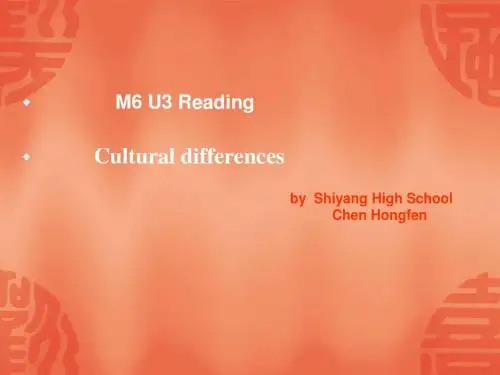
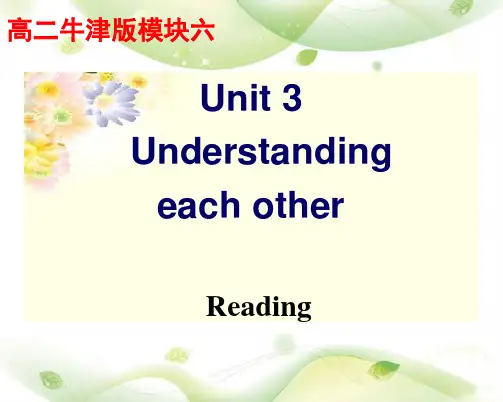
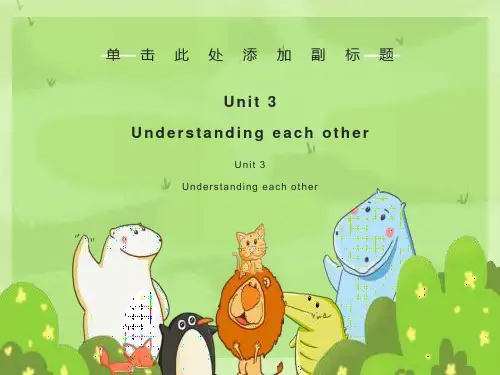
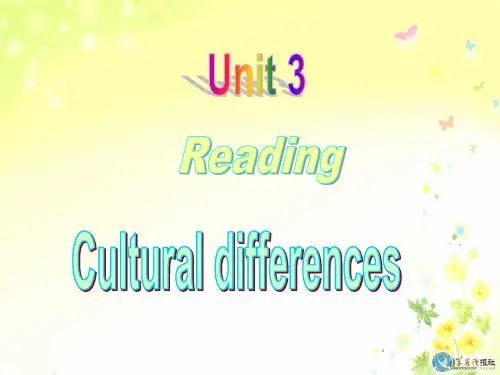
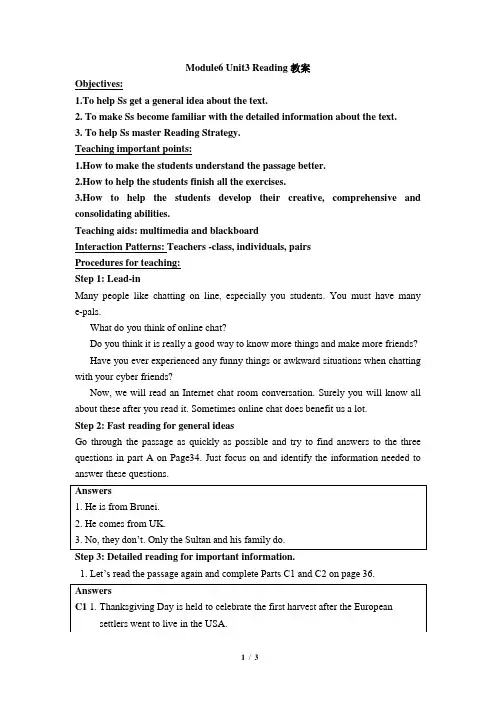
Module6 Unit3 Reading教案Objectives:1.To help Ss get a general idea about the text.2. To make Ss become familiar with the detailed information about the text.3. To help Ss master Reading Strategy.Teaching important points:1.How to make the students understand the passage better.2.How to help the students finish all the exercises.3.How to help the students develop their creative, comprehensive and consolidating abilities.Teaching aids: multimedia and blackboardInteraction Patterns: Teachers -class, individuals, pairsProcedures for teaching:Step 1: Lead-inMany people like chatting on line, especially you students. You must have many e-pals.What do you think of online chat?Do you think it is really a good way to know more things and make more friends?Have you ever experienced any funny things or awkward situations when chatting with your cyber friends?Now, we will read an Internet chat room conversation. Surely you will know all about these after you read it. Sometimes online chat does benefit us a lot.Step 2: Fast reading for general ideasGo through the passage as quickly as possible and try to find answers to the three questions in part A on Page34. Just focus on and identify the information needed to answer these questions.Step 3: Detailed reading for important information.1. Let’s read the passage again and complete Parts C1 and C2 on page 36.2. Turkey.3. In the West, the polite time to open a present is when someone gives it to a person, because they like to see the person’s reaction.4. Guests expect presents as a souvenir to remember the big day.5. Alcohol.6. In Brunel, you should use your thumb to point at things.7. In both places, you should take off your shoes before going inside a house.C2 4 7 3 1 2 6 5Step 4: Practice1. Let’s complete Part D (Re fer to the text while complete part D)AnswersD 1d 2c 3f 4g 5b 6e 7h 8a2. Now, let’s read Ma Li’s diary about her chat room discussion. Fill in blanks with correct words.E 1)traditions 2)Thanksgiving 3)harvest 4)Europe 5)celebrate6)weddings 7)embarrassing 8) presents 9)rude 10) thumbStep 5: Post-reading activities1. Now let’s make up a dialogue by using the questions in Part F on Page 37. Work in pairs for a few minutes and then present your dialogue to the whole class.2. There are also cultural differences in different English-speaking countries. For example:Americans enjoy a good sense of humour; the British take a somewhat different view and believe a formal approach is the best way; the Australians are more informal and straightforward, often enjoying a good laugh and calling their close friends or new acquaintances by their first names.1.Discussion:What might happen if people had no idea of other countries’cultures?Do you think it might result in embarrassment on inconvenience?What do you think about “culture shock”?2.Do you know more information about cultural differences?➢In most countries, nodding your head up and down means ‘yes’.➢In some parts of Greece and Turkey, however, this motion can mean ‘no’.➢In South-eas t Asia, nodding your head is a polite way of saying ‘I’ve heard you.’➢In the United Stated, when someone puts his thumb up, it means ‘Everything is all right.’ However, in Sardinia of Italy and Greece, the gesture is insulting and should not be used there.Step 6:Language PointsStep 7: Homework1. Finish Parts A1 and A2 on page116 in the workbook.2. Prepare the part Word Power.。
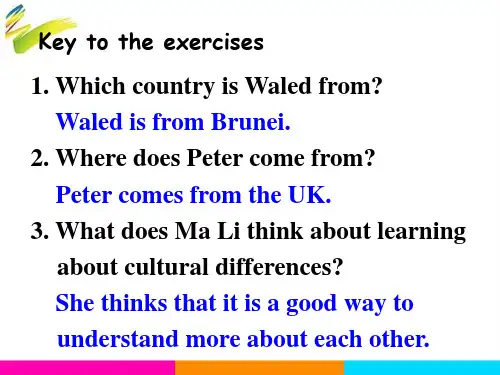
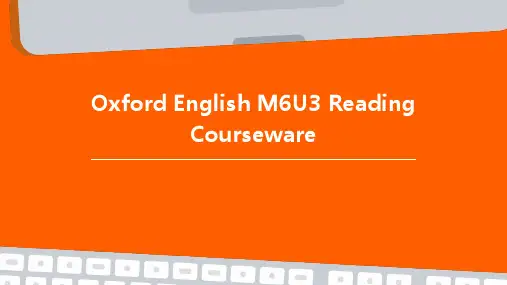

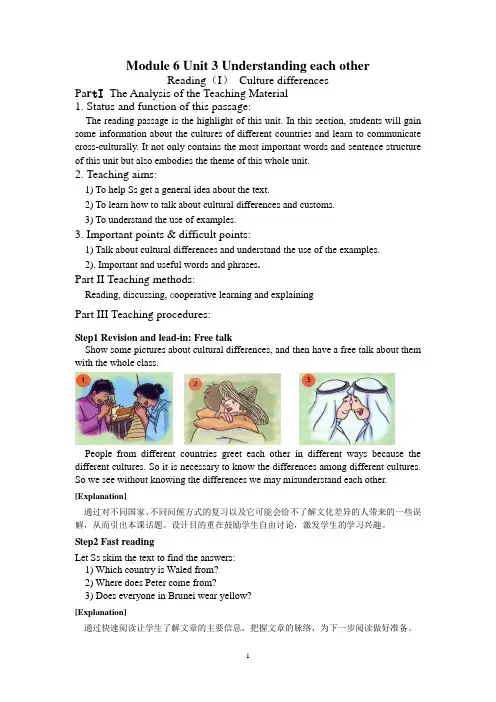
Module 6 Unit 3 Understanding each otherReading(I)Culture differencesPa r tI The Analysis of the Teaching Material1. Status and function of this passage:The reading passage is the highlight of this unit. In this section, students will gain some information about the cultures of different countries and learn to communicate cross-culturally. It not only contains the most important words and sentence structure of this unit but also embodies the theme of this whole unit.2. Teaching aims:1) To help Ss get a general idea about the text.2) To learn how to talk about cultural differences and customs.3) To understand the use of examples.3. Important points & difficult points:1) Talk about cultural differences and understand the use of the examples.2). Important and useful words and phrases.Part II Teaching methods:Reading, discussing, c ooperative learning and explainingPart III Teaching procedures:Step1 Revision and lead-in: Free talkShow some pictures about cultural differences, and then have a free talk about them with the whole class.People from different countries greet each other in different ways because the different cultures. So it is necessary to know the differences among different cultures. So we see without knowing the differences we may misunderstand each other. [Explanation]通过对不同国家、不同问候方式的复习以及它可能会给不了解文化差异的人带来的一些误解,从而引出本课话题。
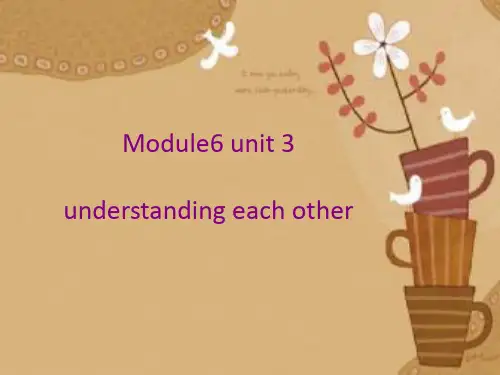
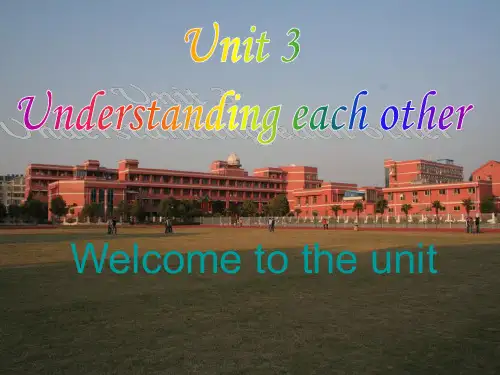
Module6 Unit3 Reading公开课学案Warming up1. How do we Chinese usually greet each other now?2. How do people from different countries greet each other?3. Why do you think that we should learn cultural differences between different nations?4. Which of the following words indicate the right attitudes towards cultural differences?respect tolerate look down upon appreciate hate understand reject Prediction: According to the title of the unit ‘Understanding each other’, guess what the reading is mainly about.Fast Reading1.What is the style of the text?2. What is the theme of the discussion?3. Which country is Waled from?4. Where does Peter come from?5. Does everyone in Brunei wear yellow?Detailed Reading1. What does Thanksgiving celebrate?2. What is eaten at Thanksgiving?3. In the West, when is the polite time to open a present? Why?4. What can you not drink at a wedding in Brunei?5. What should you do instead of pointing with your first finger in Brunei?6. What customs do Chinese cities and Brunei have in common?Reading Strategy: understanding the use of examplesThe text we read is a dialogue on cultural differences. So in this kind of text we should use examples to explain concepts and ideas.Sometimes we use examples to support arguments and sometimes used as interesting stories.1. Read the dialogue carefully and try to find out the sentences explaining the concept of cultural differences between English speakers from different countries.2. Try to find out the sentences supporting the argument that there are differences as well as similarities between West weddings.3. Try to find out the example used as an interesting story about cultural misunderstanding.参考答案Warming up3. to experience different cultures;to get a better understanding…;to help strengthen relations with…;to avoid unnecessary mistakes and embarrassment;to communicate freely and effectively,to be a polite person, etc.Fast Reading1. An internet chat room discussion.2. Cultural differences.3. Brunei.4. The UK.5. No. Yellow is the color for the royal family only.Detailed Reading1. It’s to do with celebrating the first harvest after the settlers from Eur ope went to live in the USA.2. The huge turkey.3. In the west , it is polite to open a present when someone gives you one. Because people want to see the person’s reaction.4. Alcohol.5. Pointing with our thumb.6. Taking shoes off before you go inside someone’s house.Reading Strategy1. Our American teacher is always talking about Thanksgiving…The British teachers didn’t know what he was talking about…2. In the UK, the guests are expected to give presents to the newly-weds, but in Italy …3. The British teacher who opened the present as soon as he was given it at the end-of-the term ceremony…。
Module6 Unit3要点详解:Reading部分1. Today I would like to talk to you guys and try to accumulate some more information about cultural differences because I have to do a piece of homework on cultural differences.今天我想和伙伴们谈谈,收集一些关于文化差异方面的东西,因为要做有关文化差异方面的作业。
1) accumulate: gradually get more and more Vt. 积累,聚集Reading is a good way to accumulate our knowledge.阅读是积累知识的好办法。
We must accumulate enough evidence to ensure his guilt.我们必须收集足够的证据来确定他的罪行accumulation: n.He is experienced in the accumulation of data. 他在收集资料方面有经验2) difference: n.差异点,不同之处Could you explain to me the differences between British English and American English? 你能给我解释下英美英语的区别吗?There is not much difference in colour. 在颜色上没有多大差别。
The two vases are so alike that I can’t tell the differen ce.这两个花瓶太想像了,很难分辨Whether he comes or not will make a big difference.他来不来有很大影响。